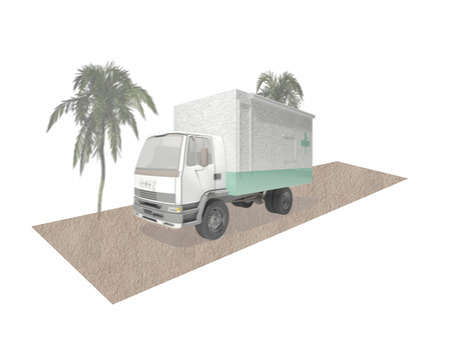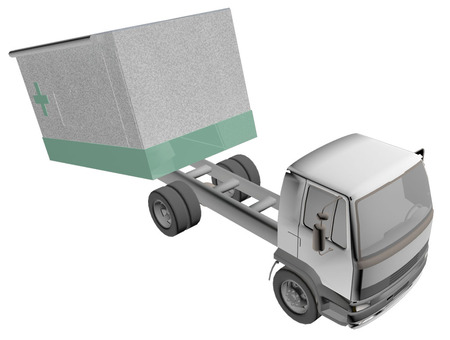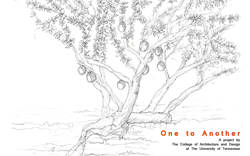Emergency Response Unit: Doctors on Demand
 Monday, February 18, 2013 at 10:45PM
Monday, February 18, 2013 at 10:45PM  Unit Enroute to Disaster ZoneWith a background in emergency services and a few years of designs for Haiti under my belt, I was excited to begin this project. My initial idea was to revisit the idea of an ambulance, adapting it for post disaster Haiti. After working through several iterations with Caroline McDonald and Lauren Metts, we decided that due to the lack of resources post disaster dedicating a vehicle to a emergency response unit was a poor idea. We then worked through the way that we could deliver a emergency response unit that could function as a self-sustainable medical clinic.
Unit Enroute to Disaster ZoneWith a background in emergency services and a few years of designs for Haiti under my belt, I was excited to begin this project. My initial idea was to revisit the idea of an ambulance, adapting it for post disaster Haiti. After working through several iterations with Caroline McDonald and Lauren Metts, we decided that due to the lack of resources post disaster dedicating a vehicle to a emergency response unit was a poor idea. We then worked through the way that we could deliver a emergency response unit that could function as a self-sustainable medical clinic.
We looked at the way PODS (portable on demand storage) units are delivered, as well as dumpsters that are rolled off of a truck here in the states. We decided to utilize the mechanics of these systems to remove our unit from the back of a typical Haitian cab over truck. Our unit is designed to be removed from the back of a cab over chassis with a hand winch and removable jacks. After removal from the chassis, the removable jacks can be utilized to level the unit on uneven terrain.
 Unit being removed from cab over truck
Unit being removed from cab over truck
We designed the unit to accommodate a four person medical crew in the shelter of the unit. Retractable awnings with removable sides on each side provide for a flexible layout that can accommodate most any needs. The interior of the unit contains bulk medical supplies and sleeping quarters for the staff. In the event that a extremely private exam is necessary, the interior bunks can be utilized for just such an exam. Exterior storage includes a large rescue style compartment that contains removable benches, spine boards, and various tools that could be used in collapse rescue situations. Two compartments that open downward on each side become a work surface for a medical provider and contain a limited amount of necessary medical supplies.
Living conditions on the interior are tight, but comfortable. The top bunks fold up to allow extra head room for the bottom bunks to become a bench during the day. Storage is included under the bottom bunks to utilize every inch of space. A water storage tank can store in excess of 600 gallons of clean water to be used as the medical personell see fit. Ventilation is provided by small ports at floor level that introduce fresh air into the unit, and a large vent along the center of the roof structure that exhausts the air from within. A small amount of electricty could be produced by photovoltaic panels mounted to the top of the unit. This electricty could be used to charge two way radios, cell phones, or life saving medical equipment.
In order for this unit to become a piece of the Haitian culture, it is designed to be based at a local hospital. Post disaster, the unit will be dispatched to the disaster area and delivered by a modified cab over truck. After initial set up, the unit will begin functioning as designed. To alleviate concerns of the Haitian people about the origins of the unit, it is design to accomodate typical colors seen in Haitian healthcare environments. Local Haitians could paint a mural on the exterior of the unit, eventually turning the unit into a mobile canvas that tells a story of the disasters it has seen or good hygenie practices. Unit awaiting initial setup
Unit awaiting initial setup



